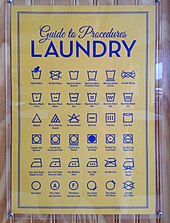Laundry symbol



A laundry symbol, also called a care symbol, is a pictogram indicating the manufacturer's suggestions as to methods of washing, drying, dry-cleaning and ironing clothing. Such symbols are written on labels, known as care labels or care tags, attached to clothing to indicate how a particular item should best be cleaned. While there are internationally recognized standards for the care labels and pictograms, their exact use and form differ by region. In some standards, pictograms coexist with or are complemented by written instructions.
Standards[]
GINETEX, the France-based European association for textile care labelling, was formed in 1963 in part to define international standards for the care and labelling of textiles.[1] By the early 1970s, GINETEX was working with ISO to develop international standards for textile labelling, eventually leading to the ISO 3758 standard, Textiles – Care labelling code using symbols.[2][3] ISO 3758 was supplemented in 1993, revised in 2005 and again in 2012 with reviews of the standard held on a five-year cycle.[2]
In North America, the Standards Council of Canada in 1987 adopted CAN/CGSB-86.1-M87, a colour-based textile care labelling system where green indicated "go ahead", yellow "be careful", and red "stop". In 2003, this system was withdrawn in favor of a pictogram-based system harmonized with North American and international standards.[4][5] In 1996, ASTM International published a system of pictorial care instructions as D5489 Standard Guide for Care Symbols for Care Instructions on Textile Products with revisions in 1998, 2001, 2007, 2014, and 2018.[6][7]
Additional textile care labelling systems have been developed for Australia, China, and Japan.[5] Worldwide, all of these systems tend to use similar pictograms or labelling to convey laundry care instructions.[8] As of 2021, the pictograms are not encoded in Unicode.[9]
Pictograms[]
General[]
The care label describes the allowable treatment of the garment without damaging the textile. Whether this treatment is necessary or sufficient, is not stated. A milder than specified treatment is always acceptable. The symbols are protected and their use is required to comply with the license conditions; incorrect labelling is prohibited. A bar below each symbol calls for a gentler treatment than usual and a double bar for a very gentle treatment.
Washing[]
A stylized washtub is shown, and the number in the tub means the maximum wash temperature (degrees Celsius). A bar under the tub signifies a gentler treatment in the washing machine. A double bar signifies very gentle handling. A hand in the tub signifies that only (gentle) hand washing (not above 40 °C) is allowed. A cross through washtub means that the textile may not be washed under normal household conditions. In the North American standard, dots are used to indicate the proper temperature range.
In the European standard, the level of wash agitation recommended is indicated by bars below the wash tub symbol. Absence of bar indicates a maximum agitation (cotton wash), a single bar indicates medium agitation (synthetics cycle) and a double bar indicates very minimal agitation (silk/wool cycle).[10] The bar symbols also indicate the level of spin recommended with more bars indicating lower preferred spin speed.[10]

Washing symbol

Wash at or below 30 °C (USA, 1 dot, ●)

Wash at or below 40 °C (USA, 2 dots, ●●)

Wash at or below 50 °C (USA, 3 dots, ●●●)

Wash at or below 60 °C (USA, 4 dots, ●●●●)

Hand wash

Do not wash
Bleaching[]
An empty triangle (formerly lettered Cl) allows the bleaching with chlorine or non-chlorine bleach. Two oblique lines in the triangle prohibit chlorine bleaching. A crossed triangle prohibits any bleaching.

Bleaching symbol (allowed for both chlorine and non-chlorine bleach)

Bleaching with chlorine allowed (obsolete)

Non-chlorine bleach when needed

Do not bleach

Do not bleach
Drying[]
A circle in the square symbolizes a clothes dryer. One dot requires drying at reduced temperature and two dots for normal temperature. The crossed symbol means that the clothing does not tolerate machine drying. In the U.S. and Japan, there are other icons for natural/line drying.
Tumble drying[]

Tumble drying symbol

Tumble drying (low temperature)

Tumble drying (normal)

Do not tumble dry
Natural drying[]

Drying symbol

Line dry

Dry flat

Drip dry

Dry in the shade

Line dry in the shade

Dry flat in shade

Drip dry in shade
Ironing[]
The iron with up to three dots allows for ironing. The number of dots are assigned temperatures: one prescribes 110 °C, two for 150 °C and three for 200 °C. An iron with a cross prohibits ironing.

Ironing symbol

Iron at low temperature

Iron at medium temperature

Iron at high temperature

Do not iron
Professional cleaning[]
A circle identifies the possibilities of professional cleaning. A bar under the symbol means clean gently, and two bars means very gentle cleaning.
Chemical cleaning[]
The letters P and F in a circle are for the different solvents used in professional dry cleaning.

Professional cleaning symbol

Dry clean, hydrocarbon solvent only (HCS)

Gentle cleaning with hydrocarbon solvents

Very gentle cleaning with hydrocarbon solvents

Dry clean, tetrachloroethylene (PCE) only

Gentle cleaning with PCE

Very gentle cleaning with PCE

Do not dry clean
Wet cleaning[]
The letter W in a circle is for professional wet cleaning.

Professional wet cleaning

Gentle wet cleaning

Very gentle wet cleaning

Do not wet clean
References[]
- ^ "Who We Are". ginetex.net. GINETEX. Retrieved 25 April 2021.
- ^ Jump up to: a b ISO 3758:2012 — Textiles — Care labelling code using symbols
- ^ "Japan adopts the GINETEX textile care labelling symbols" (Press release). International Apparel Foundation. 21 June 2016. Retrieved 25 April 2021.
- ^ "Guide to Apparel and Textile Care Symbols". IC.GC.ca. Office of Consumer Affairs.
- ^ Jump up to: a b "Care Label Recommendations" (PDF). Intertek. 2019. Retrieved 25 April 2021.
- ^ "ASTM D5489: Standard Guide for Care Symbols for Care Instructions on Textile Products". West Conshohocken, Pennsylvania: ASTM International. doi:10.1520/D5489-18. Retrieved 25 April 2021.
- ^ Ortiz, Gerald (5 August 2020). "Care Tag Labels Decoded – What Do Those Laundry Symbols Mean?". Heddels. Retrieved 25 April 2021.
- ^ "Caring About the Consumers Beyond the Label" (PDF). Intertek. 2014. Retrieved 20 April 2014.
- ^ "Laundry care symbols in Word, Excel and PowerPoint". Office Watch. 25 March 2019. Retrieved 25 April 2021.
- ^ Jump up to: a b "Care Symbols". ginetex.net. GINETEX. Retrieved 2018-03-21.
External links[]
| Wikimedia Commons has media related to Laundry symbols. |
- GINETEX: The International Association for Textile Care Labelling-Care Symbols
- ISO 3758:2012 — Textiles — Care labelling code using symbols
- Home Laundering Consultative Council — What Symbols Mean
- The revised Canadian standard
- Swedish care symbols
- United States care symbols
- Further care symbols, including Japanese
- US, Japanese, and UK woven washing label symbols
- Laundry Guide to Common Care Symbols — Textile Industry Affairs
- Guide to Common Home Laundering & Drycleaning Symbols — Textile Industry Affairs
- Consumer symbols
- Laundry
- Pictograms








































